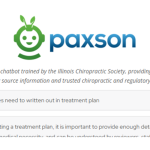
ICD 10 Changes October 1, 2024

Exciting ICD-10-CM Updates Bring Clarity to Disc Degeneration Codes
The official ICD-10 updates for Fiscal Year 2025 go into effect on October 1st, 2024. There are 252 new codes, 36 deleted, and 13 revised codes for 2025. There are also a few updates and clarifications to some guidelines. As in the past, only a few of these changes may be relevant to chiropractors and other physical medicine providers.
1. Change to disc degeneration (this is the big one)
Chapter 13 contains codes for diseases of the musculoskeletal system and connective tissue. The big change that is likely to be relevant to chiropractic is to M51.36 Other intervertebral disc degeneration, lumbar region and M51.37 Other intervertebral disc degeneration, lumbosacral region. Each of these codes will now require a sixth character, which clarifies if there is also discogenic low back pain and/or lower extremity pain.
The additions look like this (new codes in bold; the inclusion terms beneath each code, not italicized or bolded, are also official additions):
- M51.36 Other intervertebral disc degeneration, lumbar region
- M51.360 Other intervertebral disc degeneration, lumbar region with discogenic back pain only
- Other intervertebral disc degeneration, lumbar region with axial back pain only
- M51.361 Other intervertebral disc degeneration, lumbar region with lower extremity pain only
- Other intervertebral disc degeneration, lumbar region with leg pain only
- Other intervertebral disc degeneration, lumbar region with referred sclerotomal pain only
- M51.362 Other intervertebral disc degeneration, lumbar region with discogenic back pain and lower extremity pain
- Other intervertebral disc degeneration, lumbar region with discogenic back pain and leg pain
- Other intervertebral disc degeneration, lumbar region with axial back pain and referred sclerotomal pain
- M51.369 Other intervertebral disc degeneration, lumbar region without mention of lumbar back pain or lower extremity pain
- Other intervertebral disc degeneration, lumbar region without mention of lumbar back pain or leg pain
- Other intervertebral disc degeneration, lumbar region, NOS
- M51.360 Other intervertebral disc degeneration, lumbar region with discogenic back pain only
- M51.37 Other intervertebral disc degeneration, lumbosacral region
- M51.370 Other intervertebral disc degeneration, lumbosacral region with discogenic back pain only
- Other intervertebral disc degeneration, lumbosacral region with axial back pain only
- M51.371 Other intervertebral disc degeneration, lumbosacral region with lower extremity pain only
- Other intervertebral disc degeneration, lumbosacral region with leg pain only
- Other intervertebral disc degeneration, lumbosacral region with referred sclerotomal pain only
- M51.372 Other intervertebral disc degeneration, lumbosacral region with discogenic back pain and lower extremity pain
- Other intervertebral disc degeneration, lumbosacral region with discogenic back pain and leg pain
- Other intervertebral disc degeneration, lumbosacral region with axial back pain and referred sclerotomal pain
- M51.379 Other intervertebral disc degeneration, lumbosacral region without mention of lumbar back pain or lower extremity pain
- Other intervertebral disc degeneration, lumbosacral region without mention of lumbar back pain or leg pain
- Other intervertebral disc degeneration, lumbosacral region, NOS
- M51.370 Other intervertebral disc degeneration, lumbosacral region with discogenic back pain only
Keep in mind that, as of Oct. 1, 2024, M51.36 or M51.37 are no longer valid codes. A sixth character is required. Claims with these old codes will be denied. Be sure to update your billing software to reflect this change.
Excludes1 is a convention in ICD-10 that identifies when two codes are mutually exclusive, that is, they cannot be used together. Because of the new detail in these codes, there are a few new Excludes1 to be aware of. The codes above that end with the digit “1” are for lower extremity pain and therefore cannot be coded with M54.3- Sciatica. Likewise, the codes that end with “2” include discogenic back and lower extremity pain and therefore cannot be coded with M54.4- Lumbago with sciatica. And finally, the codes above that end with “0” for discogenic back pain only cannot be coded along with M54.5- Low back pain. Using these codes together could result in a claim denial.
One advantage of this change may be that, as a primary diagnosis, this additional detail can help to better establish medical necessity without the need for a review of the records. In your records, be sure to indicate the presence or absence of low back pain and/or lower extremity pain. If you report one of the codes with the sixth character, “9”, that means that you chose not to document those details.
2. Change to synovitis
The updated code set for 2025 includes the addition of the anatomic location in the upper or lower extremities for M65.9 Synovitis and tenosynovitis, unspecified. This code now requires a fifth character, which indicates shoulder (1), upper arm (2), forearm (3), hand (4), thigh (5), lower leg (6), ankle and foot (7), other site (8), and multiple sites (9). These codes also require a sixth character: right (1), and left (2). The code will only be valid with six characters, whereas it had four characters previously.
Furthermore, each of these has the option of “9” for the sixth character to indicate that the documentation does not include which extremity is involved. For obvious reasons, avoid reporting this code with the “9” as the sixth character. It implies that the provider record is unnecessarily vague about the location of the condition.
3. Socioeconomic circumstances
Chapter 21 includes codes that start with “Z,” and they represent reasons for encounters and factors influencing health status. They can be used to report detail on the claim form that reduces the need for payers to request records. In chiropractic, they might be added to a diagnosis code for a musculoskeletal condition, as an optional clarification.
- Z59.7 Insufficient social insurance and welfare support was expanded to include a fifth character. The options are as follows:
- Z59.71 Insufficient health insurance coverage
- Inadequate social insurance
- Insufficient social insurance
- No health insurance coverage
- Z59.72 Insufficient welfare support
- Inadequate welfare support
- Z59.71 Insufficient health insurance coverage
Keep in mind that there are many other Z codes that include other details that may be helpful to report along with a condition. These are just some of the new ones for 2025.
There were many other changes to the code set for 2025, but these are the ones most likely to be relevant to chiropractors and physical medicine providers. To see the complete list of changes, go to CMS.gov.

















